I mean, it doesn't get any simpler than this. But the taste, "subtle yet profound." In other words, super-delicious.
[js]
This is a dish that we resurrected from the past.
As mentioned before in our meat and potatoes post, there was a long stretch 10 to 15 years ago when we did not have beef at home.
We used to frequent a small eatery in Manila called Mr. Poon. One of our favourite dishes from that place was a steamed beef dish they brought out to the table with a burner underneath. The beef pieces were so very tender, melt-in-your-mouth tender, garnished with a lot of cilantro on top. They also doused the dish with a little bit of soy sauce tableside.
We managed to recreate this dish at home a couple of years ago for a Chinese New Year party.
[ts]
Besides the beef and cilantro, there are only three -- count 'em, three! -- other ingredients in this dish.
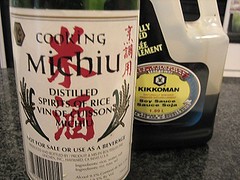
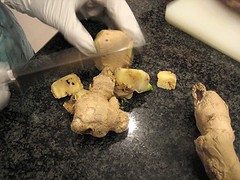
Chinese cooking wine
soy sauce
ginger
Our mother used michiu this time (pictured above), but we also use shiaoxing wine as well.
[js]
In our roster of beef applications, this dish stands as one of my all-time favourites. When done this way, beef retains its essential beefiness but does not seem to want to overpower and overwhelm with its brute strength. Unlike most North American applications of beef that seem to prize "big, bold, beef flavour," in this dish, beef is more subdued, subtle.
The aesthetic at play here is more "Asian" or "Eastern," and "the unbearable lightness of being beef" is the goal. Beef dances lightly on the tongue -- hey, maybe that's what we should call this dish!
"Dancing Beef with Cilantro"?
A name somewhat reminiscent of the famous Vietnamese beef dish, "Shaking Beef."
Choosing the right cut of beef took some time and we have tried this dish with different cuts to see which one would work best.
When TS and I first tried making this dish ourselves, we bought what is labelled "beef short plate" at the Chinese supermarket. That, it seemed to me, was closest to "beef brisket."
If I recall correctly, the dish at Mr. Poon was called Steamed Beef Brisket. But, we can never find "brisket" in a Chinese supermarket.
(Chinese cuts of beef are different from Western cuts of beef. Different culinary cultures have different ways of carving up animals -- a subject that is quite fascinating to me.)
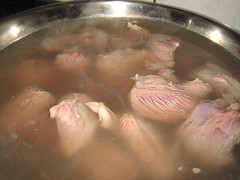 [ts]
[ts]To begin this dish, we do what Chinese people do: we "clean" the meat by dumping it in boiling water.
The water must be boiling first before the meat is put in. Then, we usually just wait until the water comes back up to a boil. When that happens, we take out the meat.
[js]
Our first attempt at "Dancing Cilantro Beef" using beef short plate yielded a still delicious dish, but it did tilt over to the "heavier" side of the spectrum. It seemed that steaming beef short plate yielded darker, more beefy beef. We noted this thusly in this conversation.
JS: "Hey, this seems beefier."
TS: "Yeah. It seems beefier than what we had before."
(Everybody chews and nods.)
JS: "Yeah. I wonder why."
(Everybody eats some more.)
TS: "Maybe it's just the difference between steaming the meat and poaching it."
(Our mother usually poaches her meat.)
JS: "Maybe."
(Everybody eats some more.)
JS: "Mother, which cut of beef do you buy [when you make this dish]?"
TS: "It doesn't look the same as what we have before."
MOM: "I don't know."
JS: "You mean you don't know the English name?"
MOM: "Yes."
I made a mental note, and when we shopped a couple of days later, I asked my mother again which cut of meat she buys when she makes dancing cilantro beef.
My mother pointed to the pieces of meat labelled "VEAL BREAST."
Oh.
Okay.
That explains a lot of things.
Namely, how she got the beef to "dance lightly" on the tongue. Veal, I suppose, is also caught in the unbearable lightness of being beef.
Okay.
We wanted to do the dish with mature dead cow. In any case, beef short plate was not the right cut of meat.
[ts]
And look at that! This is the water used to "clean" the meat. Look at all that scum!
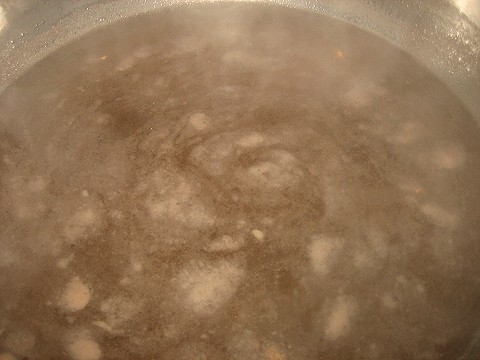
[js]
Fast forward a couple of years, another confusing turn. Another conversation, this time on bulalo (Filipino beef soup).
JS: "Which cut of beef do you buy for bulalo?"
LSC: "Beef brisket."
JS, very confused: "Beef brisket? Where do you find beef brisket?"
LSC: "At the supermarket."
JS: "Which supermarket?"
LSC: "Different supermarkets. Richmond public market."
JS: "I have never seen beef brisket in a Chinese supermarket before."
LSC: "Well, that's where I buy my beef brisket."
LSC insists that she has bought beef brisket in Chinese supermarkets. I am confused. Where are they hiding all the beef brisket?
[ts]
While the beef was being "cleaned", we prepared the poaching liquid. Again, a dump-into-a-pot process.... umm, with the heat on, of course.
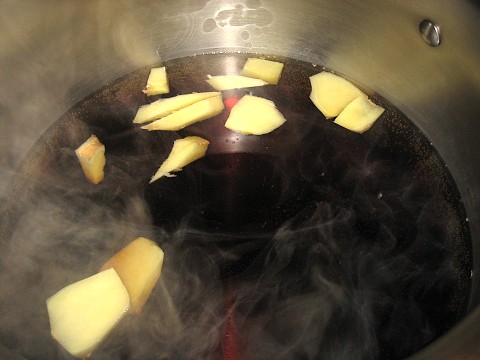
That's water, soy sauce, Chinese cooking wine and ginger. Don't forget the water! We want the resulting liquid to be "light", subtle yet profound.
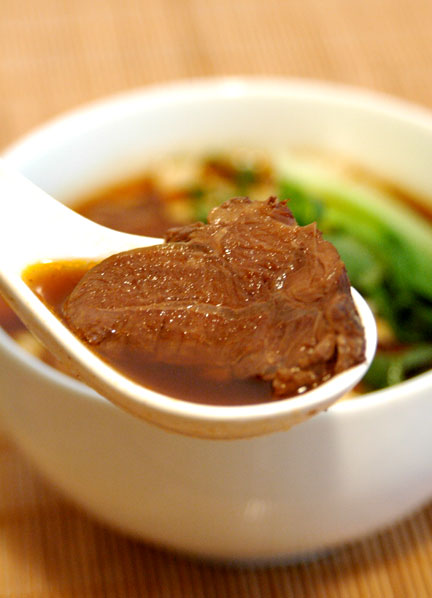 [js]
[js]Researching recipes for Taiwan beef noodle, I came across this site: http://eatdrinknbmerry.blogspot.com/2007/02/nrm-20-revisit-of-niu-rou-mian-chinese.html.
Hey, look at the picture he has! (Image used with permission.)
That looks like what we have come to know as "beef brisket" in Chinese restaurants!
Armed with new information, I confronted LSC.
JS: "Do you mean you buy beef shin at the supermarket for your bulalo?"
LSC: "No, I buy beef brisket!"
JS: "Is that what you say? When you tell the meat person that you want to buy the beef?"
LSC: "Yes! I say, 'Please give me the beef brisket.'"
JS: "What does the beef brisket look like?"
LSC: "I don't know!"
JS: "Is it kind of shin-like? Like your calf muscle?"
LSC: "Um, I don't know. Kind of, I guess."
JS: "Then it's beef shin! Beef shin!"
LSC: "I don't know. I tell the guy beef brisket and he understands and gives me cut of meat that I like for my bulalo."
JS: "Okay. It's just different. It's a totally different part of the animal."
LSC: "I bought beef stew meat at Costco and they're not the same. They're very tough."
JS: "Okay. But it's like commenting somebody has nice legs but meaning breast, or vice-versa." (That was a bit of an exaggeration, but I have a point.)
LSC: "I just know I tell the guy beef brisket and he gives me beef brisket."
JS: "But it's totally different!"
LSC: "Okay!"
Well.
So we have a discovery: "beef shin" has been masquerading as "beef brisket" in Chinese restaurants and supermarkets for a long time.
This is beef shin!
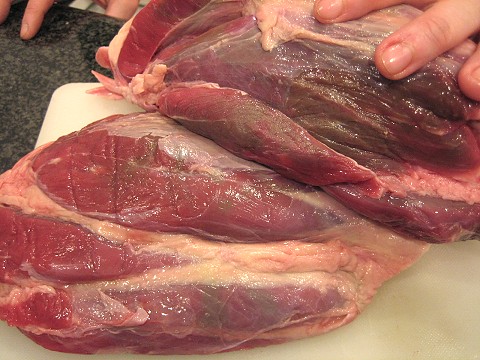
Beef shin is the cut of meat that Bill Buford (writer of Heat
Beef shin, aka "Chinese beef brisket", is delicious. When cooked for a long time, like in those Cantonese braises, it becomes buttery and tender, with a luxurious mouthfeel, and most importantly, it's not overwhelmingly beefy. It seems like we've found our winner.
[ts]
For this dish, we just cut the beef shin in large pieces. They'll all become buttery soft in the end.
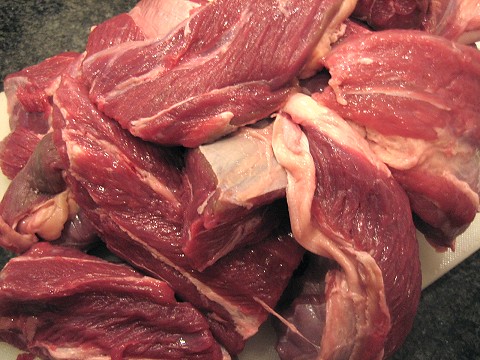
[ts]
And here they are in the poaching liquid.
I forgot to take a picture, but I added a bunch of cilantro stems into the liquid as well.
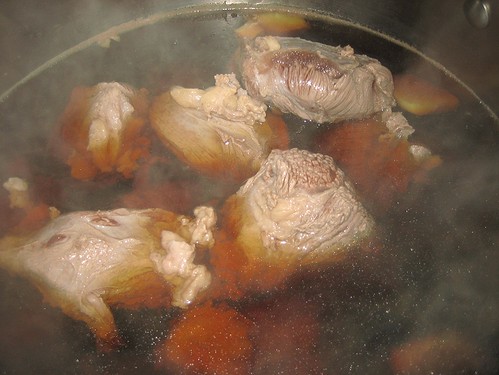
[ts]
Foolishly, we started poaching the shin too late. Well, not our fault as we couldn't get home until 4pm or so. I thought, optimistically, that they would only need about 2 hours to cook.
WRONG!
It took FOUR HOURS!
Dinner, for me and JS at least, was at 9pm. I even had to wait until the next day to take a picture so there'll be natural light, my best friend.
BYOOTIFUL!
Served on top of plain rice, of course, with lots of the poaching liquid (aka sauce).
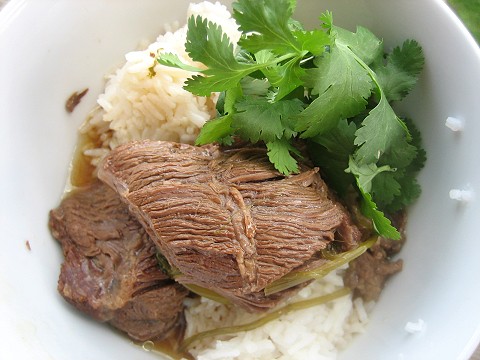
[js]
Delicious. Although the meat looks stringy, it's not dry-stringy at all. The long simmering time just makes the beef so very melty and there is a little bit of the gelatinous coating on the beef that makes it feel luxurious.
You won't even know that the cow had been standing all day on these shin muscles.
Mama Dishes
Mama's Silkie Chicken ("Dyong Kwe")
Mama's Philippine-style Fruit Salad
Mama's Cilantro Beef Shin
Mama's Black Peppercorn Shortribs
Mama's Fish Head Soup
Mama's Giniling
Mama's Giniling, v4 and v5
Mama's Ampalaya (Bitter Melon)
Ma-Kut (Pork Bone) Soup
4 hrs? I think it's worth it though I don't think I'm that patient to wait that long.
ReplyDeleteRecently, I made beef noodles soup with some stewing meat cubes. It is just not the same beef noodles I've tasted here in Taiwan.
Thanks for sharing the beef knowledge. Now I know beef brisket is known as beef shin. ;)
It would've been OK if we just started this earlier. Then we could've just "set it and forget it".
ReplyDeleteTaiwan beef noodles is on our to-do list. We're doing research on the soup, the noodles, and especially those pickled vegetables they have! We have some leads, hehe, but any insight from the people in Taiwan? =)
wow - great post
ReplyDeleteyou guys are ON it
beef shin... where will i get this? i wanna make it...
claudia,
ReplyDeleteBeef shin is usually available in Asian supermarkets. It's one of their standard cuts of meat. It usually comes in the form we've pictured.
Is there a 99 Ranch, Ranch 99, TNT supermarket, in Nashville and its environments? (These are the trade names the company goes by: they're all owned by the same President group.)
If not in Asian supermarkets, butchers will have beef shank. Sometimes, they cut it crosscut like osso buco. In our parts of the woods, butchers or "regular" supermarkets don't usually carry it and it would usually need to be special-ordered.
Thanks! The dish is very much in the vein of Asian home-cooking, which is a lot of "dump it into a pot and let it boil then simmer." There's probably ways to "jazz" it up, using additional techniques and improve the presentation -- but we're usually too lazy to do that.
tigerfish,
ReplyDeleteWhen I was at Costco contemplating the stew meat, I asked the meat department guys where they cut the meat from. He replied they usually cut it from the hip portion. Which might explain their toughness.
I suspect that most Western supermarkets use the hip portion for their stewing meat as well. When I look at the meat, it always seems to me to be very lean.
I just bought some beef shin in the barbq/fresh meat store in Richmond Centre across from McDonald. I was able to get them to thinly slice it for me. I will follow your cooking directions. I think it will work well using the Crockpot slow cooker. Thanks for the post.
ReplyDeleteHi Joseph,
ReplyDeleteThe crockpot should work well. It's a long, slow process that will do a lot of work breaking down the shin. We haven't tried slicing the meat really thin, though, and I wonder how the slices of meat will do in the crockpot. Let us know how it goes.
My wife always use pressure cooker. It's fast and easy.
ReplyDeleteThank you for this Mr. Poon Recipe!!!
ReplyDeleteHow much soy sauce and wine please?
ReplyDeleteAnon:
ReplyDeleteThanks for the tip. I;m still always a little afraid of using the pressure cooker, teehee. Also, BIG pressure cookers are hard to come by! We always cook large batches of things. =)
kaisernance:
Welcome!
The wine is just a tiny splash. As for the soy sauce: try 1 part soy sauce to 1 part water at first, and see how you like it. The poaching liquid is fairly watery.
Let us know how it turns out!
Thank you. Will Try tonight!
Delete